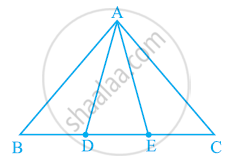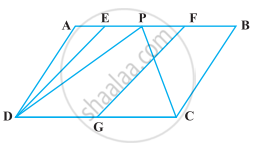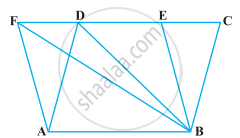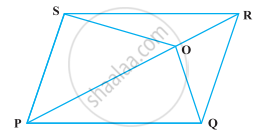Advertisements
Advertisements
Question
ABCD is a parallelogram and X is the mid-point of AB. If ar (AXCD) = 24 cm2, then ar (ABC) = 24 cm2.
Options
True
False
Solution
This statement is False.
Explanation:
Given in the question, ABCD is a parallelogram and X is the mid-point of AB.
So, area(ABCD) = area(AXCD) + area(ΔXBC) ...(i)
Now, diagonal AC of a parallelogram divides it into two triangles of equal area.
area(ABCD) = 2area(ΔABC) ...(ii)
Similarly, X is the mid-point of AB,
So, area(ΔCXB) = `1/2`area(ΔABC) ...(iii) [Median divides the triangle in two triangles of equal area]
2area(ΔABC) = `24 + 1/2` area(ΔABC) ...[By using equation (i), (ii) and (iii)]
Now, 2area(ΔABC) – `1/2`area(ΔABC) = 24
`3/2`area(ΔABC) = 24
Therefore, area(ΔABC) = `(2 xx 24)/3` = 16 cm2.
APPEARS IN
RELATED QUESTIONS
XY is a line parallel to side BC of a triangle ABC. If BE || AC and CF || AB meet XY at E and F respectively, show that
ar (ABE) = ar (ACF)
ABCD is a trapezium with AB || DC. A line parallel to AC intersects AB at X and BC at Y. Prove that ar (ADX) = ar (ACY).
[Hint: Join CX.]
In the given figure, AP || BQ || CR. Prove that ar (AQC) = ar (PBR).

In the following figure, D and E are two points on BC such that BD = DE = EC. Show that ar (ABD) = ar (ADE) = ar (AEC).
Can you answer the question that you have left in the ’Introduction’ of this chapter, whether the field of Budhia has been actually divided into three parts of equal area?

[Remark: Note that by taking BD = DE = EC, the triangle ABC is divided into three triangles ABD, ADE and AEC of equal areas. In the same way, by dividing BC into n equal parts and joining the points of division so obtained to the opposite vertex of BC, you can divide ΔABC into n triangles of equal areas.]
In a ΔABC, P and Q are respectively the mid-points of AB and BC and R is the mid-point
of AP. Prove that :
(1) ar (Δ PBQ) = ar (Δ ARC)
(2) ar (Δ PRQ) =`1/2`ar (Δ ARC)
(3) ar (Δ RQC) =`3/8` ar (Δ ABC) .
If a triangle and a parallelogram are on the same base and between same parallels, then the ratio of the area of the triangle to the area of parallelogram is ______.
In the following figure, ABCD and EFGD are two parallelograms and G is the mid-point of CD. Then ar (DPC) = `1/2` ar (EFGD).

The area of the parallelogram ABCD is 90 cm2 (see figure). Find ar (ΔABD)
O is any point on the diagonal PR of a parallelogram PQRS (Figure). Prove that ar (PSO) = ar (PQO).

In the following figure, CD || AE and CY || BA. Prove that ar (CBX) = ar (AXY).

